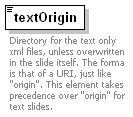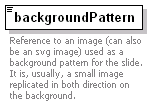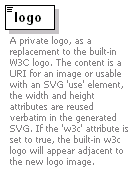| source |
<xsd:group name="Preamble">
<xsd:all>
<xsd:element name="slideMakerHome" type="xsd:anyURI" minOccurs="0">
<xsd:annotation>
<xsd:documentation>URI for the slide maker home. Will be used to locate the correct xsl file for text only slides. This element is ignored when UNIX or cygwin is used but is necessary for a Windows Command environment</xsd:documentation>
</xsd:annotation>
</xsd:element>
<xsd:element name="author" type="xsd:string">
<xsd:annotation>
<xsd:documentation>This will be put into the lower left hand corner</xsd:documentation>
</xsd:annotation>
</xsd:element>
<xsd:element name="URI" type="xsd:anyURI">
<xsd:annotation>
<xsd:documentation>This URL will turn the author field into an active element</xsd:documentation>
</xsd:annotation>
</xsd:element>
<xsd:element name="title" type="xsd:string">
<xsd:annotation>
<xsd:documentation>The title will be used on the directory slide</xsd:documentation>
</xsd:annotation>
</xsd:element>
<xsd:element name="date" type="xsd:string">
<xsd:annotation>
<xsd:documentation>This will be put into the lower right hand corner</xsd:documentation>
</xsd:annotation>
</xsd:element>
<xsd:element name="origin" type="xsd:anyURI" default="../../../Consortium/Offices/Presentations/svgs/">
<xsd:annotation>
<xsd:documentation>Directory for the svgs slides, unless overwritten in the slide itself. The format here should be that of a URI, because that is what saxon understands; preferably one uses a relative url</xsd:documentation>
</xsd:annotation>
</xsd:element>
<xsd:element name="textOrigin" type="xsd:anyURI" default="../../../Consortium/Offices/Presentations/textSlides/" minOccurs="0">
<xsd:annotation>
<xsd:documentation>Directory for the text only xml files, unless overwritten in the slide itself. The forma is that of a URI, just like "origin". This element takes precedence over "origin" for text slides.</xsd:documentation>
</xsd:annotation>
</xsd:element>
<xsd:element name="css" type="xsd:anyURI" default="http://www.w3.org/2001/svgSlidemaker/slide.css" minOccurs="0">
<xsd:annotation>
<xsd:documentation>A css file's URI, whose reference should be put at the start of each slide</xsd:documentation>
</xsd:annotation>
</xsd:element>
<xsd:element name="backgroundCss" type="xsd:anyURI" default="http://www.w3.org/2001/svgSlidemaker/background.css" minOccurs="0">
<xsd:annotation>
<xsd:documentation>A css file's URI, whose reference should be put at the start of each slide to control the background of the slide (and nothing else)</xsd:documentation>
</xsd:annotation>
</xsd:element>
<xsd:element name="backgroundPattern" minOccurs="0">
<xsd:annotation>
<xsd:documentation>Reference to an image (can also be an svg image) used as a background pattern for the slide. It is, usually, a small image replicated in both direction on the background.</xsd:documentation>
</xsd:annotation>
<xsd:complexType>
<xsd:simpleContent>
<xsd:extension base="xsd:anyURI">
<xsd:attribute name="width" type="xsd:integer" use="required"/>
<xsd:attribute name="height" type="xsd:integer" use="required"/>
</xsd:extension>
</xsd:simpleContent>
</xsd:complexType>
</xsd:element>
<xsd:element name="URIReplacement" type="URIReplacmentType" minOccurs="0">
<xsd:annotation>
<xsd:documentation>A from/to pair to replace the beginning and the end of a URI for 'a' and 'image' elements</xsd:documentation>
</xsd:annotation>
</xsd:element>
<xsd:element name="logo" minOccurs="0">
<xsd:annotation>
<xsd:documentation>A private logo, as a replacement to the built-in W3C logo. The content is a URI for an image or usable with an SVG 'use' element, the width and height attributes are reused verbatim in the generated SVG. If the 'w3c' attribute is set to true, the built-in w3c logo will appear adjacent to the new logo image.</xsd:documentation>
</xsd:annotation>
<xsd:complexType>
<xsd:simpleContent>
<xsd:extension base="xsd:anyURI">
<xsd:attribute name="width" type="xsd:integer" use="required"/>
<xsd:attribute name="height" type="xsd:integer" use="required"/>
<xsd:attribute name="w3c" type="xsd:boolean" use="optional" default="false"/>
<xsd:attribute name="href" type="xsd:anyURI" use="optional"/>
</xsd:extension>
</xsd:simpleContent>
</xsd:complexType>
</xsd:element>
<xsd:element name="rasterizer" minOccurs="0">
<xsd:annotation>
<xsd:documentation>The command to be used for rasterizing an svg file. It is, typically, a call to the batik rasterizer.</xsd:documentation>
</xsd:annotation>
<xsd:complexType>
<xsd:simpleContent>
<xsd:extension base="xsd:string">
<xsd:attribute name="width" type="xsd:positiveInteger" use="required"/>
<xsd:attribute name="height" type="xsd:positiveInteger" use="required"/>
</xsd:extension>
</xsd:simpleContent>
</xsd:complexType>
</xsd:element>
<xsd:element name="page" minOccurs="0">
<xsd:annotation>
<xsd:documentation>Add orientation to the printout page. Default is landscape, can be portrait</xsd:documentation>
</xsd:annotation>
<xsd:complexType>
<xsd:attribute name="orientation" use="required" default="portrait">
<xsd:simpleType>
<xsd:restriction base="xsd:string">
<xsd:enumeration value="landscape"/>
<xsd:enumeration value="portrait"/>
</xsd:restriction>
</xsd:simpleType>
</xsd:attribute>
</xsd:complexType>
</xsd:element>
</xsd:all>
</xsd:group> |
























